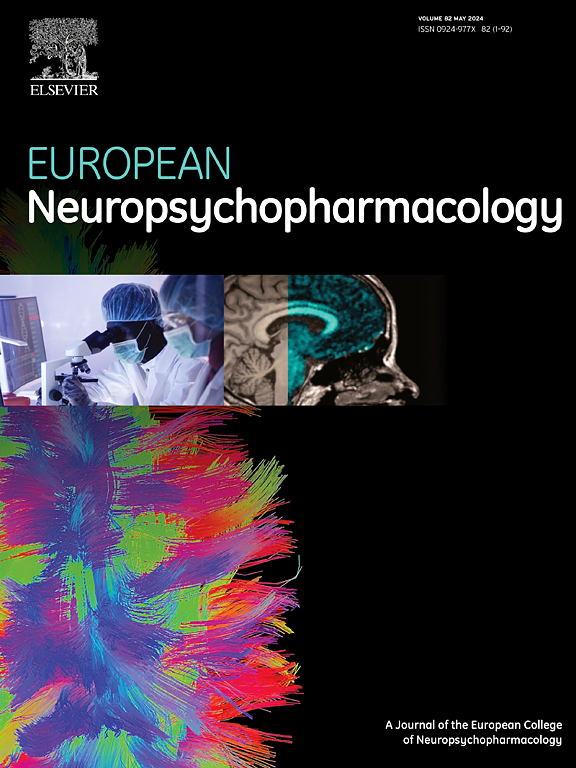边缘型人格障碍和II型双相情感障碍患者的情绪认知:跨诊断和鉴别诊断差异的证据?
IF 6.7
2区 医学
Q1 CLINICAL NEUROLOGY
引用次数: 0
摘要
由于症状重叠,区分边缘型人格障碍(BPD)和双相情感障碍II型(BD-II)具有挑战性,经常导致误诊和治疗不理想。本研究探讨了BPD患者、BD-II患者和健康对照(HC)之间情绪认知的跨诊断和诊断差异。实验程序样本包括35名BPD患者,35名BD-II缓解患者和35名HC患者。通过虚拟现实(VR)和面部表情识别任务评估情绪认知。参与者完成了关于职业和社会功能、生活质量和童年创伤的问卷调查。通过将每组患者与HC进行比较,探讨跨诊断差异,并检查BPD与BD-II之间的诊断差异。回归分析评估了童年创伤对情绪认知的影响。结果从诊断上看,患者在VR负性情境下的情绪调节能力较HC差,但在情绪面孔加工方面无显著差异。在鉴别诊断方面,BPD患者在识别情绪面孔方面比BD-II患者慢,而且准确率有降低的趋势。BPD患者和BD-II患者在VR情景下无显著差异。在所有参与者中,童年创伤预示着迟钝的情绪评级和较慢的面部情绪识别。情绪调节受损可能作为BPD和BD-II的跨诊断生物标志物,而较慢的情绪识别可能区分BPD和BD-II。在所有参与者中,童年创伤预示着迟钝的情绪评级和较慢的面部情绪识别,强调了其持久的影响。本文章由计算机程序翻译,如有差异,请以英文原文为准。
Emotional cognition in patients with borderline personality disorder and patients with bipolar disorder type II: Evidence for transdiagnostic and differential diagnostic differences?
Introduction
Distinguishing borderline personality disorder (BPD) from bipolar disorder type II (BD-II) is challenging due to overlapping symptoms, often leading to misdiagnosis and suboptimal treatment. This study explored transdiagnostic and diagnostic differences in emotional cognition between patients with BPD, patients with BD-II and healthy controls (HC).
Experimental procedures
The sample included 35 patients with BPD, 35 with BD-II in remission, and 35 HC. Emotional cognition was assessed with virtual reality (VR) and the Facial Expression Recognition Task. Participants completed questionnaires regarding occupational and social functioning, quality of life, and childhood trauma. Transdiagnostic differences were explored by comparing each patient group to HC, and diagnostic differences were examined between BPD and BD-II. Regression analyses evaluated the impact of childhood trauma on emotional cognition.
Results
Transdiagnostically, patients showed poorer emotion regulation in negative VR scenarios compared to HC, but there were no differences in emotional face processing. Differential diagnostically, patients with BPD were slower at identifying emotional faces than those with BD-II, with trends towards lower accuracy. No significant differences were observed between patients with BPD and patients with BD-II in VR scenarios. Across participants, childhood trauma predicted blunted emotion ratings and slower facial emotion recognition.
Discussion
Impaired emotion regulation may serve as a transdiagnostic biomarker for BPD and BD-II, while slower emotion recognition may distinguish BPD from BD-II. Across participants, childhood trauma predicted blunted emotion ratings and slower facial emotion recognition, underscoring its lasting impact.
求助全文
通过发布文献求助,成功后即可免费获取论文全文。
去求助
来源期刊

European Neuropsychopharmacology
医学-精神病学
CiteScore
10.30
自引率
5.40%
发文量
730
审稿时长
41 days
期刊介绍:
European Neuropsychopharmacology is the official publication of the European College of Neuropsychopharmacology (ECNP). In accordance with the mission of the College, the journal focuses on clinical and basic science contributions that advance our understanding of brain function and human behaviour and enable translation into improved treatments and enhanced public health impact in psychiatry. Recent years have been characterized by exciting advances in basic knowledge and available experimental techniques in neuroscience and genomics. However, clinical translation of these findings has not been as rapid. The journal aims to narrow this gap by promoting findings that are expected to have a major impact on both our understanding of the biological bases of mental disorders and the development and improvement of treatments, ideally paving the way for prevention and recovery.
 求助内容:
求助内容: 应助结果提醒方式:
应助结果提醒方式:


